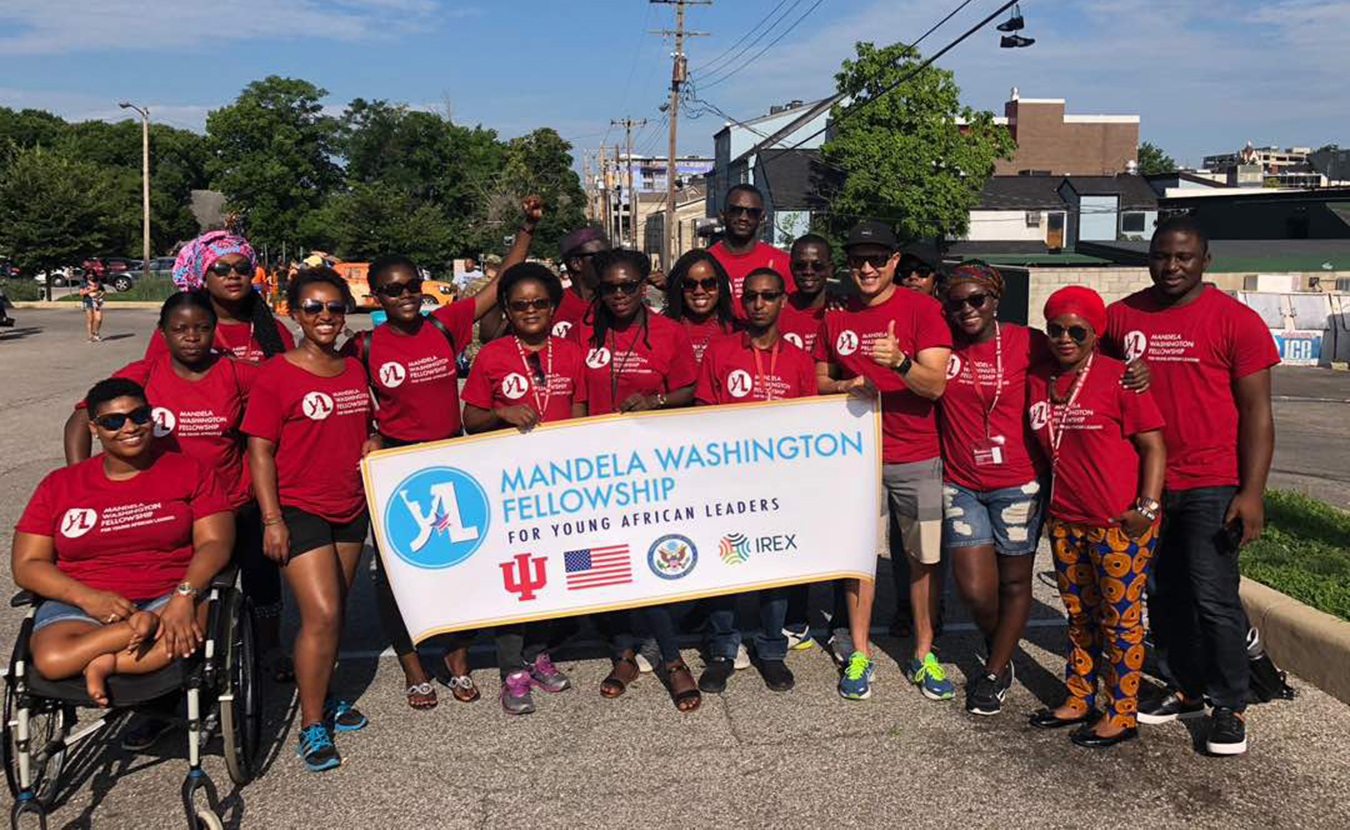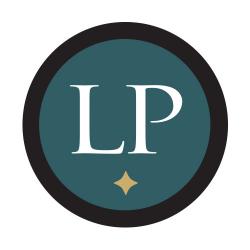[Editor’s Note: This is the second of two articles featuring young leaders who attended the Mandela Washington Fellowship at Indiana University this past summer. This article is on Eastina Marian Boimadi Taylor, from Freetown, Sierra Leone. The first was about Francis Shok Mweze, from Bukavu, the Democratic Republic of the Congo. Limestone Post asked each of them about their hometowns, their experience in Bloomington and the Mandela Washington Fellowship, and about their plans for the future.]
Eastina Marian Boimadi Taylor, from Freetown, Sierra Leone, has more than nine years’ experience working in mainstream media and media development. At BBC Media Action-Sierra Leone, Eastina produces and presents radio programs on youth issues and reducing the malaria rate in Sierra Leone. She is also the founder and coordinator of the Shaping Young Minds Initiative Academy, which focuses on changing the mindset of youth and positioning them to pursue leadership positions. Since completing the Mandela Washington Fellowship at Indiana University in July, Eastina has returned to Sierra Leone to put what she learned into practice.
About the Mandela Washington Fellowship
LP: Your Mandela Washington Fellowship bio says you plan to continue your work in media development and youth empowerment, with a focus on mentoring and leadership training. Can you tell us a bit more about that? And how did the Mandela Washington Fellowship program help you in this pursuit?
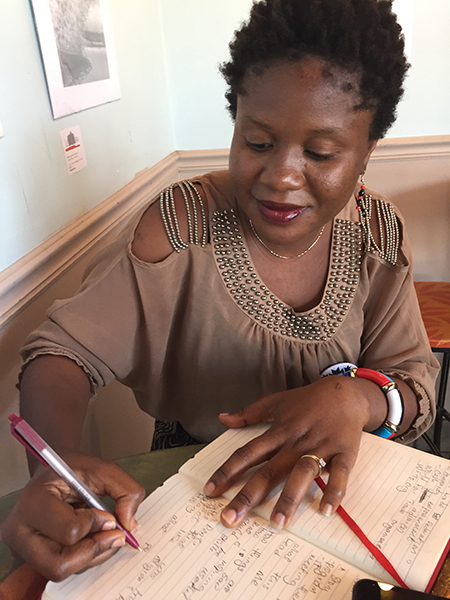
Eastina Marian Boimadi Taylor, a Mandela Fellow from Freetown, Sierra Leone, at a meeting in Soma Coffeehouse during her stay in Bloomington. | Limestone Post
Eastina: I am working as a producer for BBC Media Action. Presently I am co-producing and presenting a behavior-change communication show on malaria. Because malaria is a curable disease, we want people to make a choice to protect their families. The show is tailored around promoting the use of insecticide-treated net, prompt treatment, discouraging self-medication, and creating the platform for communities and healthcare providers to talk about the quality malaria services they offer. Before taking up the producer role, I was a mentor training community radio journalists on basic journalism, media ethics, and editorial principles.
Professionally, the fellowship is the best thing that can happen to any leader (including me). Now all I have is a burning desire to help others and fight for a worthy cause. The 24 other young people I met created sparks of new ideas in my brain. All I see now is possibilities. The only problem I have now is allocating time between my media development work and youth empowerment nonprofit [Shaping Young Minds Initiative] I run. The fellowship refined my character and attitude; now I am more confident to use my story and inspire others.
LP: What did you learn from the other Mandela Washington fellows?
Eastina: I did lots of volunteering work growing up as a little girl being part of the 1st Freetown Battalion Boy’s Brigade and also being a journalist and later mentoring others. But even after all of these achievements, I thought I was nothing. Not until I saw how other fellows and people of Indiana celebrate small achievement, then I realized that there is nothing like small success.
I learnt how to reject negative thinking, because other fellows from IU 2018 Mandela Washington Fellowship helped me focus on my strength to move forward and never allow negativity to take the front row in my life.
Before traveling for the fellowship, I used to procrastinate about everything I am passionate about and grumble about how overwhelmed I am with work and family, but now I set smart and achievable goals and push myself to reach deadlines.
LP: What did you learn from other groups or people associated with the program — at IU or any of the other Bloomington organizations you might have worked with?
Eastina: The first I noticed was, people know what they want and go for it. I was really impressed by this positive energy. I also learnt from my friends I made in Indianapolis (Lawrence Bukenya and Karmen Williams) that no matter how good your ideas are you have to transform those ideas into realities.
I went to the Hoosier Hills Career Center and I was blown away by the innovations and creativity of the pioneers. It’s such a brilliant idea to give young people the chance to start living their dreams at an early age. I thought to myself, “If there were initiatives like this in Sierra Leone, young people would be the change makers in their communities, thereby influencing the lives of other young people.”
More about Bloomington
LP: What were your impressions of Bloomington?
Eastina: On my flight from Paris to Indiana, my mind was racing about how Bloomington looks. Because other fellows from my country were excited to go to California, Georgia, New York, and the other popular states, I was worried that I was going to one of the suburbs in America. But my journey from the airport to IUPUI campus changed my mind. One look, I fell in love with the beautiful limestone buildings and how cool and quiet it was. In the two weeks spent in Indianapolis, I dreamt about the Bloomington campus as more beautiful and modern. And so it was. In my flat, there were fancy couches, tables, washers, cooker, just as I see in the movies. It was a dream come true to live in fancy apartments like the one at the Bloomington campus and IUPUI as well. There was never a moment were I doubted how organized and systematic people are in this city.
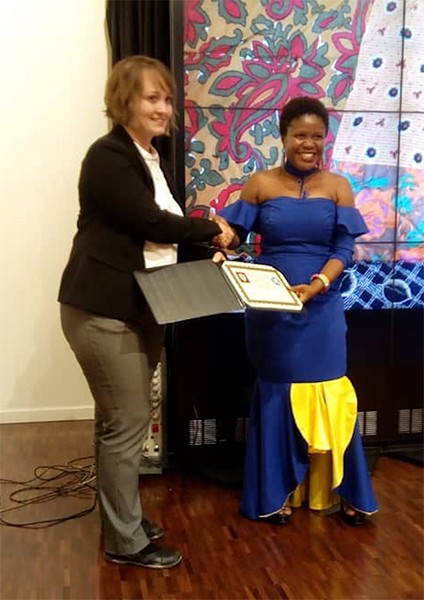
Eastina receives her certificate during the 2018 Mandela Washington Fellowship graduation ceremony. | Courtesy photo
LP: Did anything surprise you?
Eastina: Well, firstly, I was amazed at how casual people look. The Sunday I went to City for All Nations Church, I met a guy wearing a pair of jeans and grey T-shirt. He greeted me and my friends while we were ushered into the church. Only for one of the ushers to say on our way coming in, “Did you meet the pastor?” I was like, really! Pastor?
In my country and other African countries, pastors are always dressed official, with suits and ties and pointed shoes. One can even be looked at as a sinner for wearing tight pants, T-shirts, and sneakers to church. I marveled at his simplicity throughout his sermon. He spoke about giving not to people we know but the ones that are in dire need.
Also, I was shocked by the way people were surprised when we told them we made our African dresses. I saw the smiles on their faces as they stared at our bold and beautiful fabrics. It was surprising, but I felt good about wearing African designs.
LP: Was there anything in particular that you found pleasing or disappointing?
Eastina: Honestly, because of the different cultures and traditions, I thought I would find so many displeasing things, but that was the other way round. In Indianapolis, people gave us warm smiles, they cheered us in Bloomington on the 4th of July parade. People all over Bloomington will stop and say hi with so much excitement in their voices. Bloomington felt more like home or, if I can be honest, it felt even better. Because in Sierra Leone, apart from the people I know, nobody cheers for me in the street or offers me and my friends an umbrella on a rainy day. I met so many good people that touched my heart in so many ways. People like Lawrence Bukenya, who believed in me and made the first donation to my organization; Karmen Williams, who helped me believe that the cause I am fighting is worth believing in; and Nissy and Tim and their lovely daughter, who added me to their family. I could go on and on about people like the old lady who gave us her neck pillow because she saw how constrained we were waiting for the bus.
LP: What was the most memorable part of Bloomington?
Eastina: The Dollar Tree stores. Another fellow who was my flatmate, Ruth Gbatoe, told me that there are stores where everything is sold for one dollar. The first time we visited the dollar store located at East 10th Street, I shopped like I was crazy. Even after some weeks in Bloomington, I could still not satisfy my thirst of going to Dollar Tree.
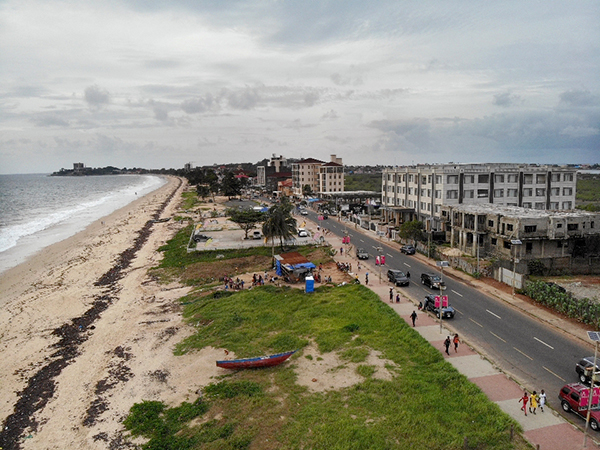
Freetown City, Sierra Leone. | Photo by Edward Kargbo City, Sierra Leone. | Photo by Edward Kargbo
LP: Did you see or experience anything or meet anybody in Bloomington that will help you with your career aspirations?
Eastina: The fellowship gave me opportunities to network with people from all walks of life. I see greater possibilities of partnering on some joint projects with the Bloomington Fire Department, Hoosier Hills Career Center, Ivy Tech [Community College], Bloomington city council, and other organizations I met with. Presently, I am even working with Karmen Williams, a Ph.D. student at IUPUI, to raise funds on gofundme.com to help deprived children in Sierra Leone with learning materials and other things that will help children learn more.
About your hometown
LP: What is the biggest difference between Bloomington and your hometown?
Eastina: Freetown is my hometown. It is the capital city of Sierra Leone. It’s a small city with hills and valleys, beautiful beaches with lovely palm trees like the Caribbean’s. But I see Bloomington as a well-planned, organized, and metropolitan city.
LP: What are the similarities?
Eastina: Freetown, just like Bloomington, shares some similar challenges like homelessness and crime. Both cities, I think, are in the process of figuring how to entice local businesses/entrepreneurs to create more jobs for its people. But most importantly, they both have beautiful landscapes and sightseeing areas.
LP: Describe your hometown and your country for our readers.
Eastina: Freetown, my hometown, has a special significance in the history of the transatlantic slave trade as the departure point for thousands of West African captives. My capital, Freetown, was founded as a home for repatriated former slaves in 1787.
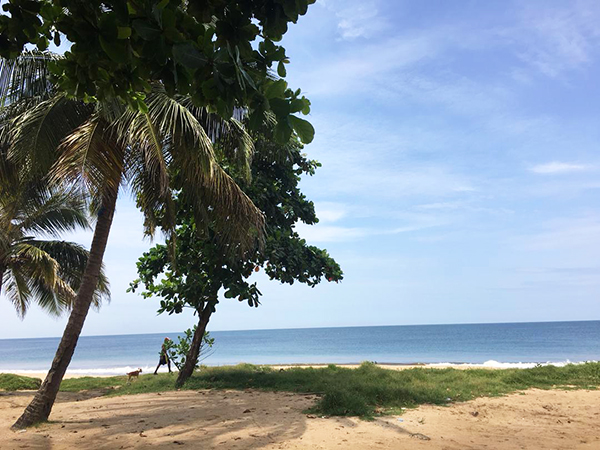
Lumley Beach in Freetown, Sierra Leone. | Photo by Daniel Bangura
Sierra Leone is situated in West Africa, flanked by Guinea in the north, Liberia in the southeast, and the Atlantic Ocean in the southwest. It covers a total area of 71,740 square kilometers [27,700 square miles, or slightly larger than West Virginia] and has an estimated population of 6 to 7.4 million.
The majority of people in Sierra Leone still live a traditional, agricultural way of life, with ruling chiefs and religions which preserve social stability, as well as local music, dance, customs, and traditions. Handshaking is the normal form of greeting.
The main minerals mined in Sierra Leone are diamonds, rutile, bauxite, gold, iron, and limonite. Mining in Sierra Leone has been seen as one of the key factors for instability in the country and one of the reasons for the country’s civil war. People from Sierra Leone are always warm and full of humor. If you are planning on visiting Sierra Leone, just know that hospitality is at the heart of everyone. I bet you will fall in love with our historic sites like Bonthe Island, beaches with white sand, and so many traditional cultures.
We also have lakes and rivers where people fish. On a beautiful day you can also go on a hike at one of the hills and valleys that surround the country. The most popular of all is Bintumani mountain that is situated at the northern province in a place called Koinadugu. Tourists come to Sierra Leone every year just to climb this mountain on Christmas holidays and to enjoy the foggy and dewy weather. You can also go to places like Tacugama Chimpanzee Sanctuary, the Banana Islands, and so many other beautiful islands.

